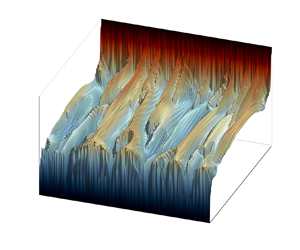Article contents
Effects of pore scale and conjugate heat transfer on thermal convection in porous media
Published online by Cambridge University Press: 29 June 2022
Abstract

The study of thermal convection in porous media is of both fundamental and practical interest. Typically, numerical studies have relied on the volume-averaged Darcy–Oberbeck–Boussinesq (DOB) equations, where convection dynamics are assumed to be controlled solely by the Rayleigh number (Ra). Nusselt numbers (Nu) from these models predict Nu–Ra scaling exponents of 0.9–0.95. However, experiments and direct numerical simulations (DNS) have suggested scaling exponents as low as 0.319. Recent findings for solutal convection between DNS and DOB models have demonstrated that the ‘pore-scale parameters’ not captured by the DOB equations greatly influence convection. Thermal convection also has the additional complication of different thermal transport properties (e.g. solid-to-fluid thermal conductivity ratio ks/kf and heat capacity ratio σ) in different phases. Thus, in this work we compare results for thermal convection from the DNS and DOB equations. On the effects of pore size, DNS results show that Nu increases as pore size decreases. Mega-plumes are also found to be more frequent and smaller for reduced pore sizes. On the effects of conjugate heat transfer, two groups of cases (Group 1 with varying ks/kf at σ = 1 and Group 2 with varying σ at ks/kf = 1) are examined to compare the Nu–Ra relations at different porosity (ϕ) and ks/kf and σ values. Furthermore, we report that the boundary layer thickness is determined by the pore size in DNS results, while by both the Rayleigh number and the effective heat capacity ratio,  $\bar{\phi } = \phi + (1 - \phi )\sigma$, in the DOB model.
$\bar{\phi } = \phi + (1 - \phi )\sigma$, in the DOB model.
- Type
- JFM Papers
- Information
- Copyright
- © The Author(s), 2022. Published by Cambridge University Press
References
Korba and Li supplementary movie 1
Temperature evolution for DOB simulation at $Ra = 5000$, $k_s/k_f = 1$ and $\sigma = 1$
Korba and Li supplementary movie 2
Temperature evolution for DOB simulation at $Ra = 10 \: 000$, $k_s/k_f = 1$ and $\sigma = 1$
Korba and Li supplementary movie 3
Temperature evolution for DOB simulation at $Ra = 20 \: 000$, $k_s/k_f = 1$ and $\sigma = 1$
Korba and Li supplementary movie 4
Temperature evolution for DNS at $Ra = 5000$, $k_s/k_f = 1$, $\sigma = 1$, $H/m = 25$ and $\phi = 0.56$
- 9
- Cited by



